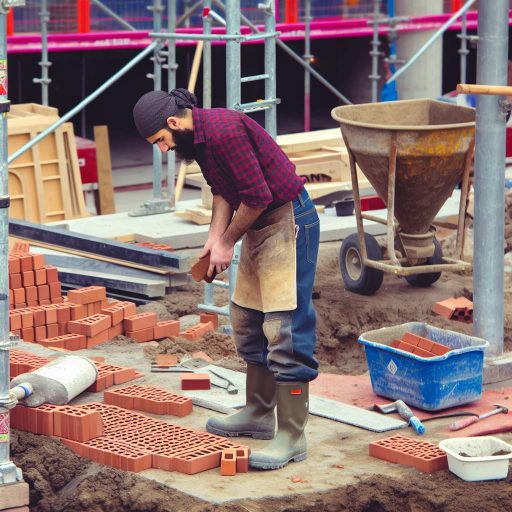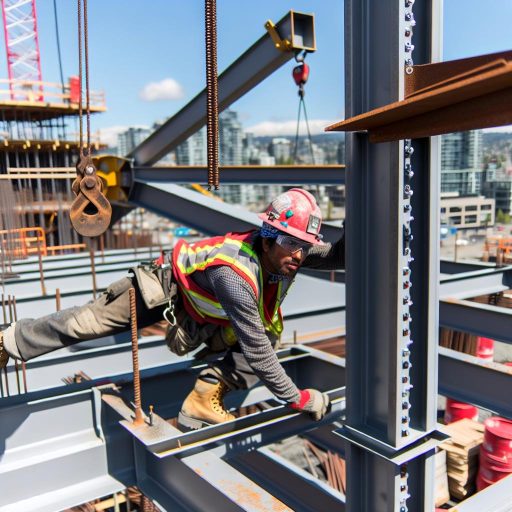Introduction to the Construction Industry in Canada
The construction industry plays a crucial role in Canada’s economy.
It creates jobs and supports various sectors, including manufacturing and services.
In recent years, the industry has experienced significant growth.
This growth arises from increasing urbanization and infrastructure demands.
Large cities like Toronto, Vancouver, and Calgary are leading this boom.
Moreover, the housing market has gained momentum, fueling construction activities.
As a result, the demand for skilled labor has risen sharply.
Bricklayers are among the most sought-after tradespeople in the current market.
They play a critical role in building structures, from homes to commercial buildings.
In addition, the need for sustainable and energy-efficient buildings has expanded their importance.
Consequently, bricklaying requires a unique blend of skills and expertise.
Many workers enter the field through apprenticeships or vocational training programs.
Organizations like the Canadian Concrete Masonry Producers Association support this training.
Furthermore, technology innovations are reshaping traditional construction methods.
Adopting new tools and techniques improves efficiency and safety on the job site.
Overall, a robust construction industry underscores the importance of skilled bricklayers in Canada.
Current Job Market Trends for Bricklayers in Canada
Overview of Demand
The demand for bricklayers in Canada has significantly increased recently.
Construction projects are surging across major provinces.
Moreover, urbanization drives the need for skilled tradespeople.
Bricklayers play a crucial role in new developments.
Regional Job Opportunities
Job opportunities vary by region in Canada.
For example, British Columbia shows a high demand due to ongoing housing projects.
Additionally, Ontario’s construction boom leads to numerous vacancies.
Alberta also offers favorable conditions for bricklayers seeking employment.
Impact of Economic Factors
The Canadian economy influences the bricklaying job market.
Unlock Your Career Potential
Visualize a clear path to success with our tailored Career Consulting service. Personalized insights in just 1-3 days.
Get StartedIncreased investment in infrastructure is a positive indicator.
Furthermore, government initiatives aim to boost housing construction.
Consequently, bricklayers benefit from these economic stimuli.
Skills Required
Skilled bricklayers must possess various essential competencies.
First, proficiency in masonry techniques is vital.
Additionally, attention to detail ensures quality workmanship.
Moreover, physical stamina is necessary for long hours in the field.
Future Prospects
The future looks promising for bricklayers in Canada.
As construction demand continues to rise, job stability increases.
Furthermore, apprenticeships and training programs support workforce development.
Ultimately, pursuing a career in bricklaying can be rewarding.
Factors Driving the Demand for Bricklayers
Growing Construction Industry
The construction industry in Canada is rapidly expanding.
This growth increases the need for skilled bricklayers.
New residential and commercial projects are emerging daily.
Moreover, infrastructure projects call for more bricklaying work.
Urbanization Trends
Urbanization continues to rise in various Canadian cities.
As more people relocate to urban areas, housing demands increase.
Bricklayers play a crucial role in meeting these housing needs.
Additionally, urban areas require commercial buildings and public spaces.
Government Initiatives
The Canadian government promotes construction through various initiatives.
Investment in infrastructure directly boosts job opportunities.
Programs aimed at revitalizing aging buildings enhance demand for bricklaying services.
These initiatives also focus on sustainable construction practices.
Technological Advancement
Innovation in construction technology affects bricklaying techniques.
Advanced tools and materials increase efficiency and precision.
Bricklayers must adapt to utilize these new technologies effectively.
This adaptation enhances job prospects in the industry.
Skilled Labor Shortage
The construction trades face a significant skilled labor shortage.
Many experienced workers are retiring without sufficient replacements.
This shortage raises salary expectations for bricklayers.
Consequently, employers actively seek skilled employees to fill gaps.
Increased Focus on Sustainability
Sustainable building practices are increasingly important in construction.
Bricklaying contributes to energy-efficient structures.
Many builders prioritize sustainable materials and techniques.
This trend augments the demand for skilled bricklayers in Canada.
Explore Further: How to Find Bricklaying Apprenticeships in Canada
Regional Demand Variations: Urban vs. Rural
Urban Demand for Bricklayers
Urban centers in Canada show a high demand for bricklayers.
Cities like Toronto and Vancouver are booming with construction projects.
These projects often require skilled bricklayers to meet architectural demands.
High-density housing and infrastructure developments create numerous opportunities.
Moreover, urban areas typically pay higher wages for skilled labor.
This trend attracts many workers to cities in pursuit of better job prospects.
Rural Demand for Bricklayers
In contrast, rural areas present a different scenario for bricklayers.
Although the demand is lower, it remains steady for certain projects.
Rural communities often focus on smaller-scale constructions.
Residential homes and local commercial properties require skilled craftsmanship.
Additionally, these areas may offer unique opportunities in rural renovation projects.
Despite lower wages, some workers prefer the lifestyle rural areas provide.
Comparative Analysis of Urban and Rural Opportunities
The urban market offers a plethora of opportunities for bricklayers.
In comparison, rural markets may provide less frequent but consistent work.
Workers in urban areas often benefit from diverse projects.
However, those in rural settings can experience a close-knit community environment.
Some bricklayers may choose to work seasonally between both regions.
This allows for tailored job experiences depending on personal preferences.
Influencing Factors on Demand
Several factors influence the demand for bricklayers across regions.
Economic growth in urban areas tends to drive construction demand.
Conversely, rural demand relies on population growth and local investments.
The availability of skilled labor also affects regional demand patterns.
Moreover, changes in building regulations can shift opportunities significantly.
Hence, understanding these factors helps anticipate future demands.
Discover More: Why Roofers Are Essential to Construction Projects
Impact of Immigrant Populations on the Bricklaying Workforce
Contribution to Workforce Diversity
Immigrant populations significantly enhance the diversity of the bricklaying workforce.
They bring unique skills and perspectives to the industry.
As a result, Canada benefits from a richer cultural fabric within the construction sector.
Addressing Labor Shortages
Canada faces ongoing labor shortages in skilled trades like bricklaying.
Immigrants often fill these gaps effectively.
They provide much-needed workforce support to meet rising demand.
Consequently, this influx helps maintain project timelines and quality standards.
Training and Skill Development
Many immigrant workers undergo extensive training to meet Canadian standards.
Programs are in place to assist with skill recognition and certification.
This commitment to training ensures a qualified workforce.
Moreover, various organizations facilitate workshops and seminars for skill enhancement.
Economic Impact
Immigrant bricklayers contribute significantly to Canada’s economy.
Their participation supports local construction firms and boosts overall productivity.
Therefore, their presence fosters economic growth through job creation.
Additionally, they often invest back into their communities, enhancing local economies.
Community Integration
Integrating immigrant workers into the bricklaying community fosters collaboration.
Shared experiences lead to stronger relationships among workers.
Furthermore, this collaboration encourages knowledge sharing and mentorship.
As a result, both seasoned and new bricklayers thrive in an inclusive environment.
Find Out More: Career Growth Potential for Metal Fabricators in Canada

The Role of Technology in Bricklaying and Its Effect on Demand
Understanding Modern Techniques
Technology has significantly reshaped the bricklaying trade.
Advanced tools allow for more precise work.
These techniques improve overall efficiency and reduce labor costs.
Moreover, bricklaying robots are emerging in construction sites.
These robots can lay bricks faster than human workers.
As a result, they change the demand for traditional bricklayers.
Impact on Job Opportunities
Although technology can replace some tasks, it also creates new roles.
Technicians are needed to operate advanced machinery.
Additionally, skilled workers are vital for quality control.
Consequently, the labor market is evolving rather than shrinking.
Overall, technology enhances job prospects in the field.
Training and Skills Development
With new technologies, training becomes essential for bricklayers.
Workers must adapt to changing tools and techniques.
Many training programs now emphasize technological literacy.
These programs help workers stay relevant in their jobs.
Ultimately, continuous learning is crucial for career growth.
Future Trends in Bricklaying
The future of bricklaying looks promising with technology’s influence.
Smart construction sites will become more common.
Moreover, sustainable practices will gain importance.
Employers will seek workers knowledgeable in eco-friendly materials.
Technology will drive demand for skilled bricklayers.
You Might Also Like: Financial Planning Tips for Canadian Bricklayers
Training and Certification Programs for Aspiring Bricklayers
Overview of Bricklaying Training
Bricklaying training provides essential skills for construction professionals.
One can engage in both classroom instruction and hands-on experience.
Moreover, comprehensive programs cover various bricklaying techniques.
Types of Training Programs
A variety of training programs exist for aspiring bricklayers.
- Vocational schools offer focused bricklaying courses.
- Community colleges provide associate degrees in masonry.
- Apprenticeship programs allow for learning on the job.
Certification and Licensing
Certification demonstrates proficiency and enhances job prospects.
Bricklayers in Canada often pursue certifications through trade organizations.
Organizations like the Red Seal Program offer recognition across provinces.
Skills Developed During Training
Training cultivates both technical and practical skills.
Aspiring bricklayers learn how to read blueprints effectively.
They also develop masonry techniques essential for high-quality work.
Problem-solving skills are critical for overcoming construction challenges.
Career Advancement Opportunities
Graduates of bricklaying programs can explore various career paths.
They may specialize in different areas such as restoration or commercial construction.
Additionally, with experience, some may move into supervisory roles.
Continuous education keeps bricklayers updated with industry trends.
Future Projections for the Bricklaying Profession in Canada
Current Demand for Bricklayers
The demand for bricklayers has been steadily increasing in Canada.
Several factors contribute to this rising need.
Construction projects are on the rise nationwide.
Urbanization leads to more residential and commercial building.
Additionally, infrastructure development adds to the demand.
Job Growth Trends
Industry analyses forecast significant job growth for bricklayers in the coming years.
Employment opportunities are expected to increase as projects expand.
Moreover, skilled tradespeople remain in high demand across various sectors.
Government initiatives aim to encourage more individuals to enter the trades.
Impact of Technology and Innovation
Technological advancements will shape the future of bricklaying.
For instance, new tools improve efficiency and accuracy in construction.
Robotics and automation are enhancing productivity on job sites.
However, demand for skilled bricklayers remains essential, as technology cannot completely replace human labor.
Training and Education Opportunities
More training programs are essential to meet future demands.
Vocational schools and community colleges offer specialized courses.
Apprenticeship programs provide valuable hands-on experience.
Moreover, these initiatives help ensure a skilled workforce for the future.
Regional Variations in Demand
The demand for bricklayers varies across Canada’s provinces and territories.
Major urban centers like Toronto and Vancouver experience higher demand.
Conversely, rural areas may see fluctuations based on project availability.
Understanding regional trends will help aspiring bricklayers find opportunities.
Future Outlook
Overall, the future looks promising for bricklayers in Canada.
As construction continues to thrive, job prospects will expand.
Furthermore, commitment to training and education will help meet this need.
Consequently, skilled bricklayers should look forward to a stable and rewarding career.
Additional Resources
Strategies to alleviate Canada’s impending construction labour …




